Essential Guide to Mushroom Foraging in Canadian Forests
Discover my expert tips for safe mushroom foraging in Canadian forests. Learn to identify edible species, best hunting spots, and essential gear for your next foraging adventure.
SURVIVAL POSTS
Kathrine-Anne Hill
11/2/202410 min read
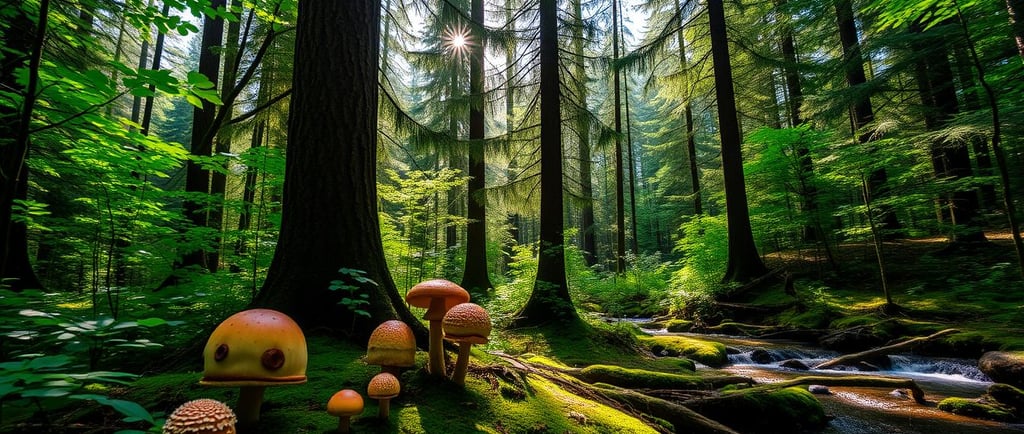

Affiliate Disclosure:
Please note that some of the links in this article are affiliate links. This means that if you click on these links and make a purchase, I may receive a small commission at no additional cost to you. This commission helps support the maintenance and growth of this website and allows me to continue providing valuable information and recommendations. Rest assured, I only recommend products and services that I have personally used or thoroughly researched. Your support is greatly appreciated! “As an Amazon Associate I earn from qualifying purchases.” For full disclosure see our Privacy Policy and Terms and Conditions here.
Essential Guide to Mushroom Foraging in Canadian Forests
Have you ever wondered what hidden delights lie within Canada's lush forests? If you love food or nature, finding wild, edible mushrooms might excite you. Mushroom foraging in Canada is a fun way to enjoy the outdoors and find tasty treats. But, where do you start?
In this guide, I'll show you the basics of mushroom foraging in Canada. We'll cover the best tools, easy-to-find mushrooms, and top spots for foraging. Whether you're new or experienced, you'll learn how to go mushroom hunting safely and with confidence.
Key Takeaways
Mushroom foraging is a popular pastime in Canada, where you can explore nature and find delicious edibles.
This guide provides essential information for beginners, covering tools needed, popular foraging locations, and beginner-friendly mushrooms to identify.
Safety is emphasized, with the importance of proper identification and following local regulations stressed throughout.
Discover the best seasons and environments for finding a variety of wild mushrooms in Canadian forests.
Learn about the essential tools and equipment required for safe and successful mushroom foraging.
Getting Started with Mushroom Foraging in Canada
I love foraging for wild mushrooms in Canada's forests. It's become more popular, and I now teach many classes. People want cleaner, healthier food, and foraged mushrooms offer that.
Benefits of Wild Mushroom Harvesting
Foraging connects you with nature. It lets you find and eat wild mushrooms. It's a fun way to get healthy food and feel self-sufficient.
Understanding Foraging Regulations
Know the rules before you go mushroom hunting. In Canada, you can forage on Crown land and private land with permission. But, national and provincial parks have rules against it. Always check the local laws to forage right.
Best Seasons for Foraging
The best times for mushroom hunting change by region. In the Pacific Northwest, it's from mid-August to November, with a spring season too. Plan your trips for the best times to find what you want.
Mushroom hunting in Canada is rewarding and educational. Knowing the rules and when to go helps you enjoy nature's edible fungi safely and sustainably.
Essential Tools and Equipment for Safe Foraging
For mushroom identification and foraging gear, the right tools are key. They make your outdoor adventures better and keep you safe. Quality equipment is important for a good time and for being kind to nature.
A good guide is a must. The Peterson Field Guide to Mushrooms of North America is great. It tells you about different mushrooms, where they live, and if they're safe to eat. This guide has helped me a lot, making me feel sure when I'm out foraging.
A strong, sharp knife is needed for picking mushrooms without hurting them. Choose one that feels good in your hand.
Mesh bags or baskets are best for collecting mushrooms. They let spores spread and help the environment. Baskets that you can carry on your back are great for long days out.
Wearing gloves, like leather or rubber, protects your hands. They keep you safe from thorns and bad stuff when you touch mushrooms.
A cool backpack or insulated container keeps mushrooms fresh. This means they taste better and stay good.
For different places, you might need more tools. Like a Hori Hori knife for digging, berry rakes, and pruners. Binoculars are also good for seeing mushrooms in places you can't reach.
Having the right gear and being ready is key for safe mushroom foraging. Good equipment makes your time better, keeps you safe, and helps nature stay healthy.
The VylerSky Mushroom Foraging Kit is highly recommended and comes with a mesh bag and a knife with a brush.
Prime Locations for Mushroom Foraging
I love searching for mushrooms in Canada's forests. From British Columbia's rugged lands to Ontario's magical woods, there's much to find.
Forest Types and Environments
Each forest type is home to different mushrooms. In British Columbia, over 200 species exist. About 10 are safe to eat, and five could be harmful.
Talking to local mushroom groups, like the Vancouver Mycological Society, helps find the good ones.
Protected vs. Permitted Areas
Foraging is allowed on some lands but not all. National and provincial parks are off-limits to protect nature.
Regional Hot Spots Across Canada
Vancouver Island and the Cowichan Valley: Full of oyster mushrooms, small boletes, porcini, chanterelles, and morels.
Toronto's Don Valley: Has many edible mushrooms, like chicken of the woods and hedgehogs.
Southwestern Ontario: Offers many mushroom types, from pheasant backs to hen of the woods.
Cape Breton, Nova Scotia: Shows off Canada's forests with chanterelles, lobster mushrooms, and bear's head.
Foraging for mushrooms requires patience, knowledge, and love for nature. Exploring these spots lets you find tasty mushrooms and connect with the earth.
Safety Guidelines and Basic Principles
Safety is key when mushrooming and foraging. As a mushroom lover, I've learned a few important rules. First, only pick mushrooms you're 100% sure are safe. Picking the wrong one can be very dangerous.
Also, don't forage in places that might be polluted. Roadsides and areas treated with chemicals can make mushrooms unsafe. Learning from experts or joining a mycological society is also a good idea.
Always err on the side of caution when identifying mushrooms
Avoid foraging in areas that may be contaminated or chemically treated
Seek out advice and mentorship from seasoned mushroom enthusiasts
Following these safety tips makes mushrooming fun and safe. It's important to think about your health and the environment when foraging.
"Being a responsible mushroom collector is vital to ensure the sustainability of all mushroom species and the wildlife that depends on them."
By following these safe foraging practices, you can enjoy Canada's mushrooms. You'll also help protect the ecosystems they live in.
Common Edible Mushrooms in Canadian Forests
Mushroom foraging is fun in Canada's forests. Many edible mushrooms are there for those who love to explore. You can find Chanterelles, Morels, Puffballs, Lion's Mane, Chicken of the Woods, and Hedgehogs.
Chanterelles and Morels
Chanterelles have bright orange or yellow caps that look like trumpets. Morels have a honeycomb-like cap. Both are loved for their taste and are found in spring and early summer.
Puffballs and Lion's Mane
Puffballs are white, round mushrooms that puff out spores when pressed. Lion's Mane has icicle-like spines. It's good to eat and might help you feel better.
Chicken of the Woods and Hedgehogs
Chicken of the Woods looks like orange shelves and tastes like chicken. Hedgehogs are light to dark brown with spiny structures. They're found in late summer and fall.
Each mushroom is special and has its own home in the forest. Foragers in Canada find them exciting and rewarding to find.
Identification Techniques for Wild Mushrooms
Knowing how to identify mushrooms is key for safe foraging in Canada's forests. I've found that looking at cap shape and color, gill or pore structure, stem features, and where they grow is vital. Using a good field guide or talking to experts can also help a lot.
Some mushrooms are easy to spot because of their unique features. For example, Morels have pitted caps and Lion's Mane has cascading spines. But with over 10,000 species in British Columbia, it can be hard to tell them apart.
It's important to learn how to identify mushrooms before you start foraging. The best time to find wild mushrooms in southern BC is from August to November. So, make sure you're ready during this time.
Key Identification Techniques
Look at the cap: Notice its shape, color, and any special features like pits or scales.
Check the gill or pore structure: The pattern, color, and how they attach to the stem can give clues.
Examine the stem: Look at the texture, color, and any rings or bulbs at the base.
Think about the habitat: Mushrooms often grow in certain places, so note the vegetation, soil, and moisture.
Use a field guide or ask an expert: Books like "All the Rain Promises and More" by David Arora can help you identify mushrooms.
Some mushrooms look like poisonous ones, so be careful. Making spore prints and carefully looking at all the mushroom's features are important steps. With practice, you'll get better at finding the tasty wild mushrooms in Canada's forests.
By learning how to identify mushrooms, you can safely find the tasty ones in Canada's forests. Happy hunting!
Sustainable Harvesting Practices
As mushroom foragers, we must follow sustainable practices. This helps keep our environment healthy. It also makes sure these amazing fungi stay plentiful in Canadian forests.
Environmental Impact Considerations
Sustainable foraging is more than just taking what we need. It's about keeping the ecosystem healthy for the future. We should not over-harvest or mess with the natural habitats where mushrooms live.
Avoid damaging or killing native plants, as it affects the whole ecosystem.
Don't rake the forest floor, as it harms the fungi's underground network.
Let mushrooms sporulate, so they can reproduce and grow more.
Proper Cutting and Collection Methods
How we harvest mushrooms is key to their growth. Using gentle methods helps these valuable resources last longer.
Use a clean, sharp knife to cut mushrooms at the base, without harming the mycelium.
Plucking mushrooms can encourage them to grow more.
Collect specimens carefully for identification, to avoid damage.
Sustainable foraging is not just for our fun. It's about keeping nature's balance. By following these steps, we help Canadian mushrooms thrive for years to come.
Storage and Preservation Methods
Storing and preserving mushrooms is key to enjoying their taste long after picking. Some mushrooms, like Shaggy Mane, should be eaten within hours. Others can be dried, frozen, or pickled to last longer.
Cleaning and processing mushrooms quickly is important to keep them fresh. The best way to preserve them depends on the type. Let's look at the different methods:
Drying: Dried wild mushrooms can last months or even years. Porcini, morels, and black trumpet mushrooms are often dried. It takes 6-12 hours to dry them to a crisp.
Freezing: Frozen mushrooms can last 6-12 months if cooked first. Hen of the Woods mushrooms are best frozen raw. Chicken of the Woods and others are sautéed before freezing.
Pickling: Pickled mushrooms are great with salads. This method works best for young, firm mushrooms. Always use tested recipes because mushrooms are low in acidity.
It's important to follow the right steps for each preservation method. This helps keep the mushrooms' taste and texture. Rehydrating dried mushrooms, blanching before freezing, and using tested pickling recipes are key.
"Preserving mushrooms allows for enjoying them for months after the harvest."
Common Mistakes to Avoid While Foraging
Mushroom picking and foraging can be fun and rewarding. But, it's important to be careful to avoid mistakes that could harm your health. As a forager in the Canadian wilderness, I've learned a lot about wild mushrooms.
Look-alike Species
Identifying edible mushrooms can be tricky. Many mushrooms look similar, but some are very dangerous. For example, the deadly Amanita virosa looks like the tasty Chanterelle. The Cortinarius rubellus can be mistaken for the prized Porcini.
Getting these mushrooms wrong can cause serious illness or even death. So, it's key to learn how to identify mushrooms correctly before you go out.
Toxic Varieties to Watch For
Some mushrooms are poisonous and should be avoided. Most mushrooms are safe, but some can be dangerous. Knowing how to spot toxic mushrooms like the Destroying Angel and Death Cap is key.
It's crucial to stay away from these mushrooms to stay safe.
Harvesting Etiquette
Foraging is more than just avoiding bad mushrooms. It's about being kind to the environment and respecting others. When picking mushrooms, always respect private property and don't take too many.
Also, leave the forest as you found it. Don't harm the delicate ecosystems. Let most mushrooms stay to keep the forest healthy.
By being careful, learning, and foraging responsibly, you can enjoy wild mushrooms in the Canadian wilderness. Remember, the secret to safe and fun mushroom picking is caution, knowledge, and respect for nature.
Conclusion
Exploring Canadian forests for mushrooms is rewarding and fun. With the right knowledge and tools, mushroom lovers can explore safely. They can find many types of wild, edible mushrooms, like Chanterelles and Morels.
I will keep learning and always think about safety and nature. Harvesting mushrooms the right way lets me enjoy their taste and help the forest. This journey needs patience, curiosity, and love for nature.
If you love mushrooms or want to start, go for it! This guide is just the beginning. It will help you find the amazing things in Canada's forests.
Related Posts:

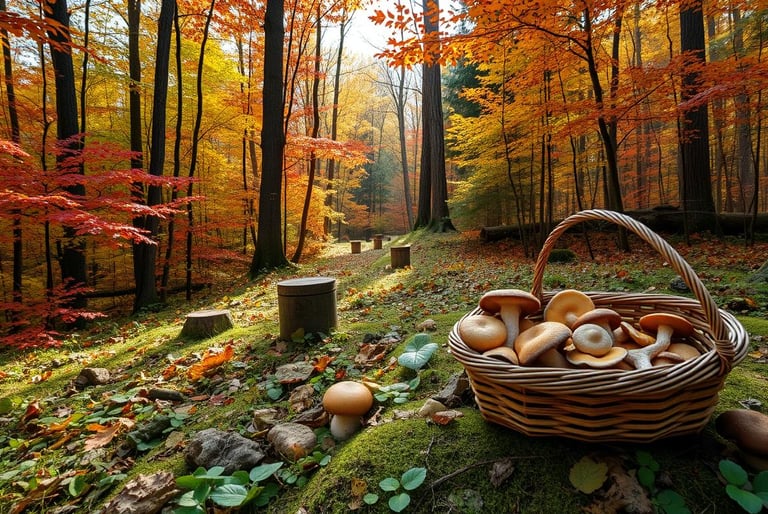


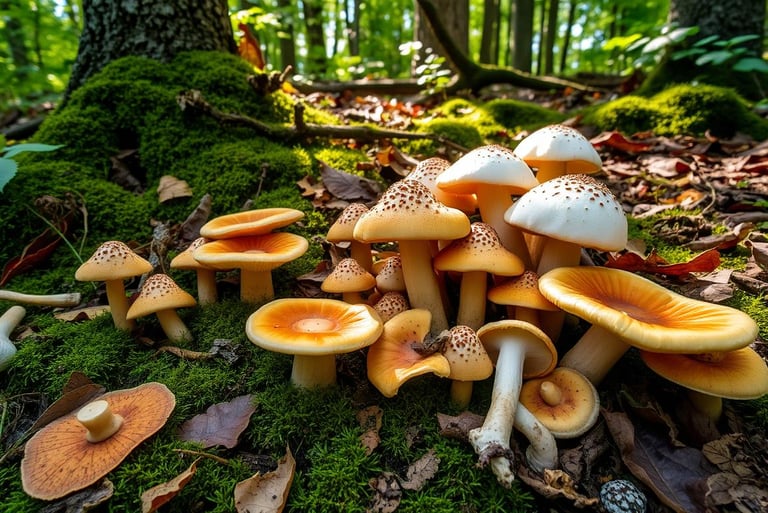

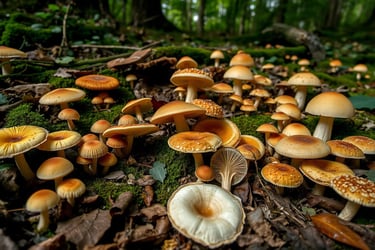


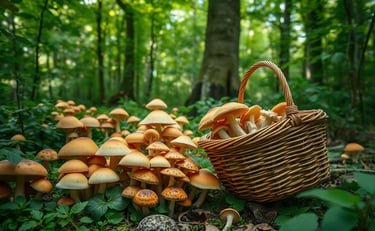
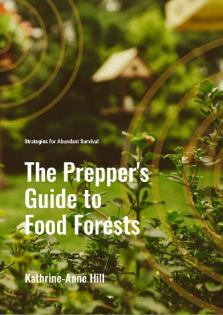

The Prepper's Guide to Food Forests: Strategies for Abundant Survival is a concise, step-by-step guide to creating a self-sustaining food forest. Ideal for preppers, it covers essential topics like design, plant selection, permaculture, companion planting, and wildlife integration. Learn how to maintain your forest, boost yields, and make it part of your survival strategy.
Highlights:
Basics of food forests and their benefits
Designing and selecting resilient plants
Creating a self-sustaining ecosystem
Using permaculture and companion planting
Maintenance, harvesting, and wildlife habitats
Food forests as part of a prepper strategy
Perfect for anyone seeking long-term food security.
Sign-Up and receive my FREE eBook The Prepper's Guide to Food Forests: Strategies for Abundant Survival !
As always, be sure to check our website for more wilderness tips and gear updates!
